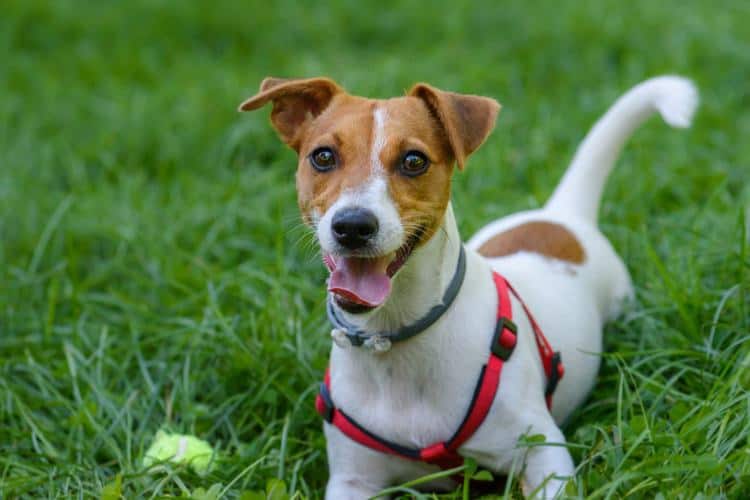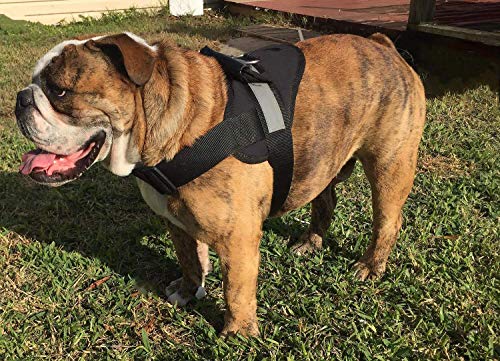Taking your dog on walks is one of your responsibilities as a pet owner. Even if you have a spacious backyard that he has free reign within, you’ll still need to have him on a leash occasionally – taking him to the vet, for example. And if nothing else, the walks you take with your pup will help him socialize and interact with the world to keep him calmer on the whole. Walking on a leash for most dog parents is an unavoidable task, but if done properly, can be a very pleasant experience for you and your dog. Owning a dog who pulls on a leash, though, can make you dread going for walks. Fortunately, there are solutions. Using an anti-pull harness can greatly reduce or even eliminate pulling behaviors in most dogs, and is an affordable option for many pet owners.
For more harness options that are suitable for while you’re driving, check out our list of dog car harnesses.
We reviewed dozens of no-pull dog harnesses to identify the best of the best. Our picks are selected based on features such as comfort and durability, cost, customer feedback, and other buying considerations.
Early in our research, we found that the PetSafe Easy Walk Dog Harness was the obvious pick for our top spot. It’s highly-rated by customers, comes in a range of colors, and genuinely helps to prevent your dog from pulling without hurting them. What more could you want in a no-pull harness?
The 5 Top-Rated No-Pull Dog Harnesses
| Editor Picks | Brand | Rating |
|---|---|---|
| Best Overall | PetSafe Easy Walk Dog Harness | 4.4 |
| Runner Up | Blueberry Pet Mesh Padded Dog Harness Vest | 4.5 |
| Best Budget Buy | Sporn Non-Pull Mesh Dog Harness | 4.4 |
| Best Reflective Dog Harness to Stop Pulling | HDP Big Dog No Pull Dog Harness | 4.3 |
| Best Dog Harness with Handle | Kurgo Journey Air Dog Harness | 4.4 |
*Ratings are from Amazon at the time of publication and can change
Our Top Pick: PetSafe Easy Walk Dog Harness
The PetSafe Easy Walk Dog Harness is our top pick for a multitude of reasons. It was developed by a veterinary behaviorist over a decade ago, and has since established a strong reputation as a go-to harness that’s recommended by vets and dog trainers alike. It’s little wonder why, given that it effectively helps to prevent dogs from pulling while out on walks.
It features a front chest leash attachment which allows you to steer your dog to the side to reduce or eliminate leash pulling. We love that its dog-friendly design won’t gag or choke your dog, so you won’t need to worry about hurting them whenever you use it. Another thing we love about this harness is that it features an easy on/off design that makes for hassle-free wear.
With a variety of size and color choices, you won’t have any trouble selecting the right one for your dog. Considering all of its features and benefits, it makes sense that this is one of the most highly-reviewed no-pull dog harnesses on the market. An eye-bogglingly high number of customers have left feedback about it (17,000+ customers, in fact!), of which has been overwhelmingly positive.
PetSafe Easy Walk Dog Harness Key Features:
- Comfortable to wear
- Easy to put on and take off
- Won’t choke or gag your dog
- Variety of sizes and color
Our Runner Up Pick: Blueberry Pet Mesh Padded Dog Harness Vest
The Blueberry Pet Mesh Padded Dog Harness Vest is a lightweight dog harness that boasts an attractive design and is made from durable mesh, oxford, and polyester materials. The buckles are made from eco-friendly plastic, while the metal D-ring has been coated for increased durability. And considering how many designs, sizes and colors are available with this listing, it’s hard to imagine that there’s a dog that couldn’t use this harness.
One thing that you’ll need to worry about with a vest design for these harnesses is that there is a lot more material to soak up those mud puddles and all the gross things your dog gets into. But stains won’t be a worry with this particular harness; it’s machine washable. So after you pry your pup out of it, you can just pop it in the washer.
Blueberry Pet Mesh Padded Dog Harness Vest Key Features:
- Wide choice of sizes
- Choice of 10 colors
- Adjustable straps for ideal fit
Best Budget Pick: Sporn Non-Pull Mesh Dog Harness
The Sporn Non-Pull Mesh Dog Harness is a perfect harness to make sure your pup no longer pulls. The harness is adjustable to help get the perfect fit for every pup, while the metal ring allows you to attach a leash. This means that while he’ll be comfortable, you’ll feel safer knowing he won’t be breaking the harness and escaping.
The harness itself is made with an elasticized mesh chest piece that moves with your dog and padded restraint sleeves for added comfort. This is especially helpful for those pups who love moving around.
Sporn Non-Pull Mesh Dog Harness Key Features:
- Choice of 3 sizes
- Stainless steel ring and hook
- Designed for comfort
Best Reflective Dog Harness to Stop Pulling: HDP Big Dog No Pull Dog Harness
Soft and reflective for increased visibility, the HDP Big Dog No Pull Dog Harness features a wide, padded design for extra comfort, and that wide reflective strap will keep him safe, even if he does escape you.
The harness includes a strong D-ring which you’ll attach the leash to and that means you’ll be able to rely on the harness to keep your dog in line. Or, at least, the harness’s strength won’t give (we can’t attest for the you versus your dog strength, though). A built-in handle on top allows for more control of your dog when training, so even if he won’t stop pulling, you’ll still be able to hold him back until he learns.
HDP Big Dog No Pull Dog Harness Key Features:
- Choice of 4 sizes and a variety of colors
- Multiple color choices
- Adjustable straps for ideal fit
Best Dog Harness with Handle: Kurgo Journey Air Dog Harness
The Kurgo Journey Air Dog Harness is a vest-style harness for dogs that helps maintain control of your canine companion thanks to its design. It is made from durable, breathable, and lightweight materials to help keep your pooch comfortable. The handle on top allows for more control of your dog, so it’s particularly helpful in the early days of your leash training.
The harness has a quick-release buckling system that will let your excited dog off and out of the harness fast. And if you’ve ever tried to get your dog’s harness off of him while he’s bouncing with excitement to get it off, you’ll know exactly how convenient that fast release really is.
Kurgo Journey Air Dog Harness Key Features:
- Choice of 5 sizes
- Choice of 3 colors
- Adjustable straps for ideal fit
Who Should Buy a No-Pull Dog Harness
The obvious answer to who needs a no-pull dog harness is, “owners who have a dog that pulls.” You’ll get more frustration and physical struggle out of a walk when your dog pulls you along through the whole trip, absolutely; but there is more to it than that. Consider what pulling does and then take it a step further. If your dog has any breathing or heart problems, a collar and leash may exacerbate those problems by him pulling on his collar, and therefore, his neck, too much. And really, even without any physical concerns, a harness is just more comfortable for a dog when you take him on your walks. Certainly pulling will be more likely to cause damage if he has only a collar. A harness, preferably one that has features to prevent pulling, will help make your walks more pleasant for you both. Handles, for example, are a harness-exclusive feature that can go a long way toward teaching your dog that pulling is a no-go, particularly in the beginning.
If you’re a runner and enjoy taking your dog along with you for the occasional (or daily) jog, the harness is definitely something in which you’ll want to look at. Even if he’s a well-trained dog who does incredibly well on a leash, running adds a complication that you will inevitably struggle with from time to time. Or maybe we should say stopping presents the problem. When your dog stops unexpectedly, or when he veers off course, your holding onto him can cause you to trip up, inadvertently causing you, or your dog, injury. If you’re bigger than he is and you don’t notice he’s stopped, you could choke him with a regular collar when you continue on your run. Alternatively, if you experience a cramp and suddenly stop, without a harness, your dog may keep going and knock you over. A harness is the safest way to run with your dog.
Important Features to Consider
A no-pull dog harness should have a few important features. Here’s what to consider when selecting a dog harness to prevent pulling:
- Padding. When your dog pulls on a harness, sometimes it just looks painful. It appears that he’s pinching his skin and fur and he may be struggling to breathe. (Rest easy, he probably isn’t actually harming himself.) But when you love your pup as your family, you want to give him the comforts in life. A padded harness can go a long way towards easing the little discomforts. A no-pull harness should prevent pulling, so the comfort added with the padding shouldn’t interfere with training him not to pull. Keep in mind, though, you may not want him to be too comfortable, especially if he’s a stubborn puller.
- Handles. A harness is only as good as the dog and the dog parent. One of the most effective features on a no-pull dog harness is the handle that will help you control your dog while you’re training him. You can hold on to him to keep him by your side and that will help you a great deal when you’re leash training him. You can even use the handle to keep him safe from his curious nature; I.E. if he sees a bigger, meaner dog or if he wants to chase a ball into the road.
- Complementing leash. You may not think a special leash is important – or you may think they don’t matter in conjunction with the harness. But the truth is that a set that is designed to complement each other is far more effective than one or the other alone. You may not notice anything at all about your old leash with the new harness, but replacing an old leash with one that comes as part of a set with the harness may just make training your dog to stop pulling all the easier.
- Step-in vs. buckle-on. A step-in harness has one strap that your dog will need to step into before you buckle in the neck strap. The buckle-on harness is one that your dog can just sit still while you do all the work; meaning you won’t need him to cooperate at all, you can do it all yourself. A step-in harness will be slightly more difficult to get on than a buckle-on, but the biggest perk of the step-in style is the added durability. While most buckles won’t give, if you use the harness frequently, there is a slightly increased chance that the buckles will give over time. The strain of you both pulling while you train him will wear on the buckles a bit more than a strap that is one solid piece. Of course, the same can be said for some adjustments – make sure you keep up on maintaining a secure fit for your dog and make the necessary adjustments when it stretches over time. After all, the more places the straps can come apart, the greater the risk that they will. (Note: Another style is a vest, which slips on like a shirt – maximum comfort and security; maximum opportunity to wrestle your dog getting him into it.)
- Measurements. You have to check both the harness and your dog’s measurements before purchasing your harness. If you can’t get a harness that fits exactly as it should, the harness won’t work. He’ll be able to pull out of it, or he’ll feel discomfort which makes your walks unpleasant in a whole new way. Always make sure you get the harness’s measurements and compare. You may have to search a bit with the manufacturer to find them – particularly for adjustable harnesses. But no matter how adjustable it is, you won’t be able to adjust a large dog’s harness to fit your Maltese.
- Back clip harness vs. front clip. Most dog harnesses will have a hook to connect the leash along his back. This won’t prevent pulling as much as a front clip harness, though. Front clips will minimize the pulling and give you more control over your dog’s movements, making it very helpful in the beginning of your leash training. However, there’s more to consider. For dogs that have any kind of tracheal issues or just smaller dogs or those with a short nose, the back clip is preferable because it’s safer. A front clip runs the risk of choking, putting too much pressure on the throat and will hinder your dog’s shoulder movements. And don’t forget a front clip means you’re putting the hook directly in front of your dog’s mouth, so he’s much more likely to chew it.
Frequently Asked Questions
What is a no-pull dog harness and what does it do?
Why do dogs pull on the leash?
Are harnesses good for dogs?
Having considered all that, though, your dog may just not like the harness. That’s not uncommon and while that doesn’t necessarily mean it’s bad for your dog, it does make it harder on you. If you find that’s the case with your puppy, you’ll want to weigh your options. You can just say forget it, and not get a harness. We only recommend this if you don’t go on frequent walks or your dog isn’t a puller, though. The other option is harness training and that is likely your best bet. The end result of that training will still give the benefits of a harness, but that will probably be when you start the leash training. It’s a bit more work for you if your pup resists the harness, but you can definitely still make it work.
How long does it take to leash train a dog?
The other variable you may not like is you. If you’re consistent and have more of a master-pet relationship with your dog it may go faster than if you treat your puppy as a cute fur ball to snuggle. The answer to how long leash training takes is, unfortunately: it will take however long it takes.
It’s also important to remember that no-pull harnesses are in no way a replacement for training. Even the best equipped no-pull harness will stop your dog from pulling if you don’t provide the proper training. In fact, no-pull harnesses may actually increase a dog’s propensity to pull since there’s no discomfort involved when they do, unlike a leash and collar might. Be sure that you are properly training your dog not to pull while wearing a harness to ensure your and their safety.






















